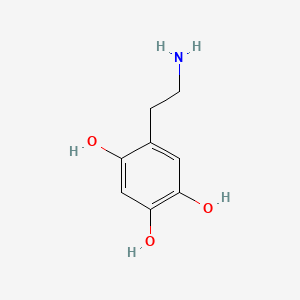Ferroptosis-centered Drug Response Information
General Information of the Drug (ID: ferrodrug0227)
| Name |
Oxidopamine
|
||||
|---|---|---|---|---|---|
| Synonyms |
oxidopamine; 6-HYDROXYDOPAMINE; 1199-18-4; 5-(2-aminoethyl)benzene-1,2,4-triol; 2,4,5-Trihydroxyphenethylamine; 6-OHDA; Hydroxydopamine; Oxidopamina; Oxidopaminum; Topamine; 1,2,4-Benzenetriol, 5-(2-aminoethyl)-; 5-(2-Aminoethyl)-1,2,4-benzenetriol; 8HW4YBZ748; CHEMBL337702; CHEBI:78741; 6-Hydroxy Dopamine hydrobromide; MLS002207128; Oxidopamine [USAN:INN]; Oxidopaminum [INN-Latin]; Oxidopamina [INN-Spanish]; 6-HD; CCRIS 4342; SMR001306725; EINECS 214-842-3; BRN 2211011; UNII-8HW4YBZ748; 5-(2-aminoethyl)benzene-1,2,4-triol;hydrobromide; 6-hydroxy-dopamine; Spectrum_000309; Spectrum2_001018; Spectrum3_001753; Spectrum4_000462; OXIDOPAMINE [INN]; Oxidopamine (USAN/INN); OXIDOPAMINE [USAN]; SCHEMBL37507; BSPBio_003486; KBioGR_000904; KBioSS_000789; 4-13-00-02916 (Beilstein Handbook Reference); DivK1c_000362; SPBio_001175; cid_176170; DTXSID0036768; BDBM81264; KBio1_000362; KBio2_000789; KBio2_003357; KBio2_005925; KBio3_002706; NINDS_000362; KUC106765N; AKOS006230272; IDI1_000362; NCGC00167769-01; NCGC00167769-02; KSC-11-228-9; NCI60_001890; SBI-0051469.P003; D05294; AB00053512_09; Q780181; 5-(2-azanylethyl)benzene-1,2,4-triol;hydrobromide
Click to Show/Hide
|
||||
| Structure |
 |
||||
| Formula |
C8H11NO3
|
||||
| IUPAC Name |
5-(2-aminoethyl)benzene-1,2,4-triol
|
||||
| Canonical SMILES |
C1=C(C(=CC(=C1O)O)O)CCN
|
||||
| InChI |
InChI=1S/C8H11NO3/c9-2-1-5-3-7(11)8(12)4-6(5)10/h3-4,10-12H,1-2,9H2
|
||||
| InChIKey |
DIVDFFZHCJEHGG-UHFFFAOYSA-N
|
||||
| PubChem CID | |||||
Full List of Ferroptosis Target Related to This Drug
Phospholipid hydroperoxide glutathione peroxidase (GPX4)
| In total 1 item(s) under this Target | |||||
| Experiment 1 Reporting the Ferroptosis-centered Drug Act on This Target | [1] | ||||
| Target for Ferroptosis | Suppressor | ||||
| Responsed Disease | Parkinson disease | ICD-11: 8A00 | |||
| Pathway Response | Fatty acid metabolism | hsa01212 | |||
| Ferroptosis | hsa04216 | ||||
| Cell Process | Cell ferroptosis | ||||
| In Vitro Model | SH-SY5Y cells | Neuroblastoma | Homo sapiens | CVCL_0019 | |
| In Vivo Model |
The AB strain of wild-type zebrafish (Danio rerio) was applied in this study. Zebrafish larvae at 4 dpf (days post-fertilization) were co-incubated with 250 uM 6-OHDA or 1.5 ug/mL nomifensine (Nomi, a dopamine transporter inhibitor) in 6-well plates at a density of 30 zebrafish embryos per group for 2 days and the medium was refreshed every day. The swimming total distance of each fish was recorded for 10 min and was analyzed by an automated video tracking system.
Click to Show/Hide
|
||||
| Response regulation | 6-hydroxydopamine (6-OHDA) treatment-induced ferroptosis in SH-SY5Y cells mainly by disturbing the protein expression of GPX4 and ACSL4. Collectively, the activation of the p62-Keap1-Nrf2 pathway prevents 6-OHDA-induced ferroptosis in SH-SY5Y cells, targeting this pathway in combination with a pharmacological inhibitor of ferroptosis can be a potential approach for parkinson's disease therapy. | ||||
Long-chain-fatty-acid--CoA ligase 4 (ACSL4)
| In total 1 item(s) under this Target | |||||
| Experiment 1 Reporting the Ferroptosis-centered Drug Act on This Target | [1] | ||||
| Target for Ferroptosis | Driver | ||||
| Responsed Disease | Parkinson disease | ICD-11: 8A00 | |||
| Pathway Response | Fatty acid metabolism | hsa01212 | |||
| Ferroptosis | hsa04216 | ||||
| Cell Process | Cell ferroptosis | ||||
| In Vitro Model | SH-SY5Y cells | Neuroblastoma | Homo sapiens | CVCL_0019 | |
| In Vivo Model |
The AB strain of wild-type zebrafish (Danio rerio) was applied in this study. Zebrafish larvae at 4 dpf (days post-fertilization) were co-incubated with 250 uM 6-OHDA or 1.5 ug/mL nomifensine (Nomi, a dopamine transporter inhibitor) in 6-well plates at a density of 30 zebrafish embryos per group for 2 days and the medium was refreshed every day. The swimming total distance of each fish was recorded for 10 min and was analyzed by an automated video tracking system.
Click to Show/Hide
|
||||
| Response regulation | 6-hydroxydopamine (6-OHDA) treatment-induced ferroptosis in SH-SY5Y cells mainly by disturbing the protein expression of GPX4 and ACSL4. Collectively, the activation of the p62-Keap1-Nrf2 pathway prevents 6-OHDA-induced ferroptosis in SH-SY5Y cells, targeting this pathway in combination with a pharmacological inhibitor of ferroptosis can be a potential approach for parkinson's disease therapy. | ||||
